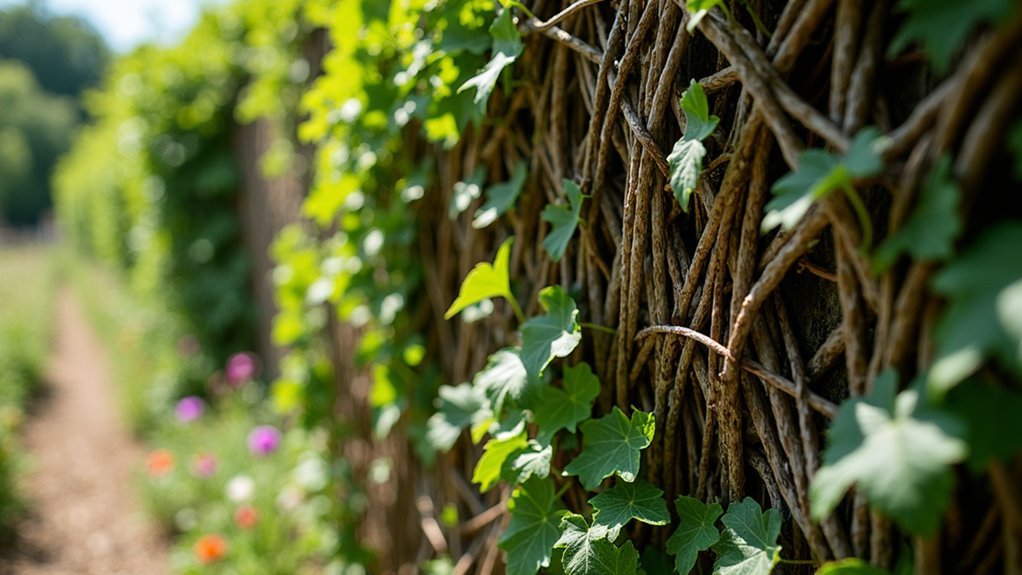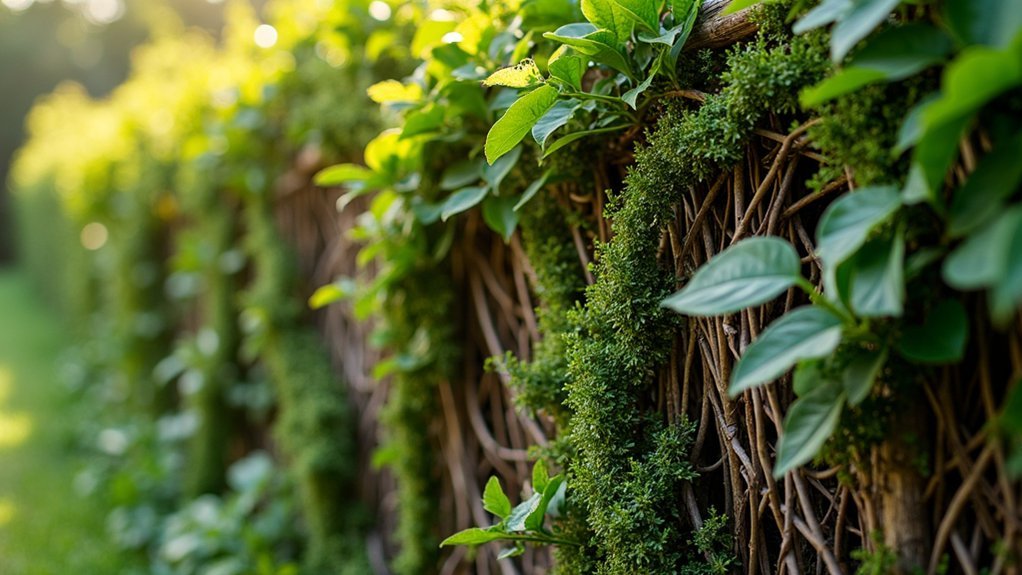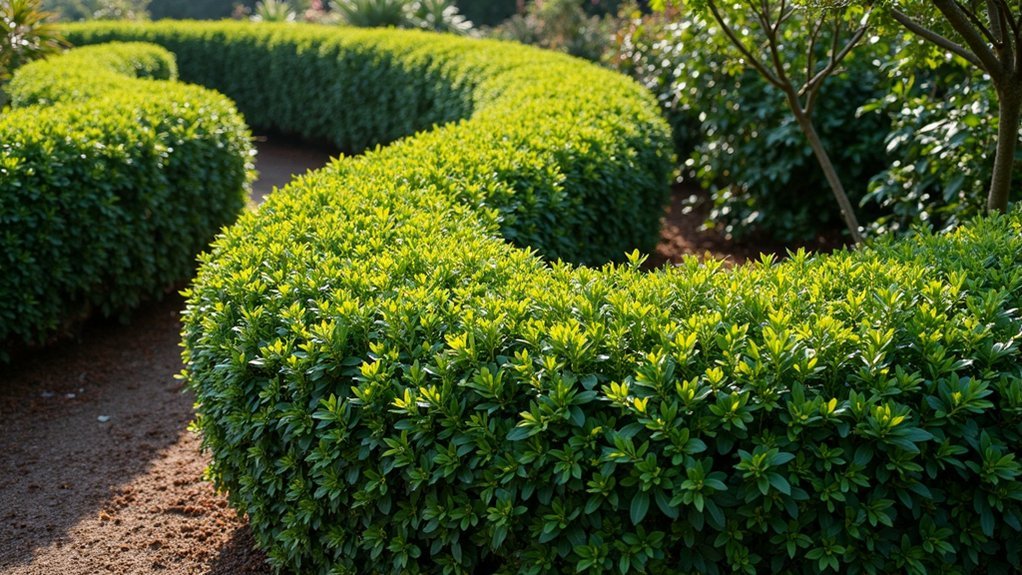Ancient hedge laying techniques include steeping (making three-quarter cuts that bend stems while maintaining health), using specialized tools like billhooks and hazel stakes, practicing regional styles that evolved since the 16th century, implementing wildlife-friendly methods that create natural corridors, and selecting appropriate plants during dormant winter months. You’ll discover how these time-honored methods create living barriers that not only contain livestock but also support biodiversity in ways modern fencing simply can’t match.
The Art of Steeping: Ancient Pleaching Methods for Lasting Hedgerows

While modern landscaping often relies on prefabricated solutions, the ancient technique of steeping remains unmatched in creating living barriers that stand the test of time.
When you master steeping, you’ll make clean cuts three-quarters through the stems, allowing you to bend them while preserving their vitality—the cornerstone of traditional pleaching.
The art of steeping breathes life into landscapes—precise three-quarter cuts preserve the plant’s essence while enabling its transformation.
You’ll need to avoid creating a “hake’s mouth” with your cuts, as this compromises the hedge’s integrity. After bending, secure the stems with crooks for stability as they establish themselves and begin to root.
This process not only rejuvenates existing hedgerows but promotes dense growth that provides habitat for diverse wildlife.
Different regional styles have evolved over generations to address local conditions and plant varieties, each preserving this sustainable practice that transforms simple plants into enduring living fences.
Essential Tools and Materials for Traditional Hedge Management
Although modern equipment has its place in landscaping, traditional hedge laying demands specific time-honored tools that connect you directly to centuries of rural craftsmanship.
When practicing hedgelaying, you’ll need a billhook for precise cutting and an axe for managing larger stems—both essential to maintaining the hedge’s structure while preserving its ecological value.
- Hazelnut stakes – Drive these into the ground to secure laid branches, creating a stable framework
- Hazel binders – Weave these flexible rods between stakes to reinforce the hedge’s structure
- Billhook and axe – Traditional tools that allow precise cuts vital for proper branch management
- Protective gear – Gloves and helmets prevent injuries when handling sharp tools
Small chainsaws can help with larger hedgerows, but always prioritize protecting the landscape’s root systems.
Regional Styles and Historical Evolution of Hedge Laying Craftsmanship

Since the early 16th century, when John Fitzherbert first documented hedgelaying techniques in 1523, this rural craft has evolved into a rich tapestry of regional styles across Britain.
The Midland, Derbyshire, and Brecon styles each developed to address specific local farming practices, livestock needs, and environmental conditions.
You’ll notice these regional variations blend uniquely at county borders, creating distinctive approaches to the craft.
The Enclosure Acts accelerated this evolution, resulting in 200,000 miles of new hedgerows as agricultural land consolidated.
The National Hedgelaying Society continues to preserve these traditional methods since its founding in 1978, recognizing their vital role in wildlife conservation.
When you examine each style closely, you’re witnessing centuries of practical adaptation to local landscapes and farming requirements.
Wildlife-Friendly Techniques From Bronze Age to Present
Despite remaining largely unchanged for millennia, Bronze Age hedgelaying techniques continue to provide extraordinary benefits for wildlife conservation today.
When you practice ancient techniques like steeping and pleaching, you’re creating living barriers that support thriving wildlife habitats while enhancing landscape aesthetics.
These time-tested methods promote biodiversity through:
- Coppicing – Encourages regrowth in thorn hedges, providing essential food and shelter for wildlife
- Strategic preservation of hawthorn and blackthorn, creating critical habitats for insects and nesting birds
- Corridor creation – Hedgerows serve as natural highways for wildlife movement across landscapes
- Environmental protection – Well-maintained hedges contribute to carbon sequestration and soil retention
Seasonal Timing and Plant Selection for Optimal Hedge Formation

The ancient craft of hedgelaying demands careful attention to both timing and plant selection for successful results.
You’ll achieve ideal growth by working during dormant winter months, from late October to March, when plants are less likely to suffer trauma and nesting birds remain undisturbed.
Choose your species wisely—hawthorn stands out for its dense growth and resilience, though blackthorn and hazel also perform admirably.
Diverse species enhance ecological benefits, creating valuable wildlife habitat for countless insects, birds, and mammals.
When cutting pleachers, always leave sufficient bark and sapwood intact to guarantee continued growth.
Secure your structure with stakes and binders, traditionally crafted from hazel wood, which provide stability to your newly formed hedge.
This careful attention to seasonal timing and proper technique preserves a living boundary that will thrive for generations.
Frequently Asked Questions
What Is the Welsh Style of Hedge Laying?
The Welsh style of hedge laying features regional techniques where you’ll cut and weave stems through steeping and pleaching. You’ll often use hazel stakes and binders for strength, creating living barriers that support wildlife habitats.
How to Lay an Old Hedge?
You’ll need to clear dead wood first, then cut stems three-quarters through, leaving a hinge. Bend them at 30-45 degrees, secure with hazel stakes and bind with rods. Work in winter for best results.
What Are the Best Hedges for Hedge Laying?
You’ll find hawthorn, blackthorn, and hornbeam are ideal for hedge laying due to their pliable stems. They’re hardy, adapt well to various conditions, and create dense barriers when properly managed.
What Are the Disadvantages of Hedge Laying?
You’ll find hedge laying has serious drawbacks: it’s physically demanding, requires skill, and consumes time. You’re also vulnerable to weather constraints, and without proper maintenance, your hedges may collapse and lose their ecological benefits.
In Summary
You’ve now discovered five timeless hedge laying methods that connect you to generations of rural craftspeople. Whether you’re rejuvenating an old boundary or starting fresh, these techniques offer both beauty and function for your landscape. By applying these ancient skills, you’ll create living fences that benefit wildlife while standing strong for decades. Start your hedge laying journey today—your land and local ecosystem will thank you.





Leave a Reply